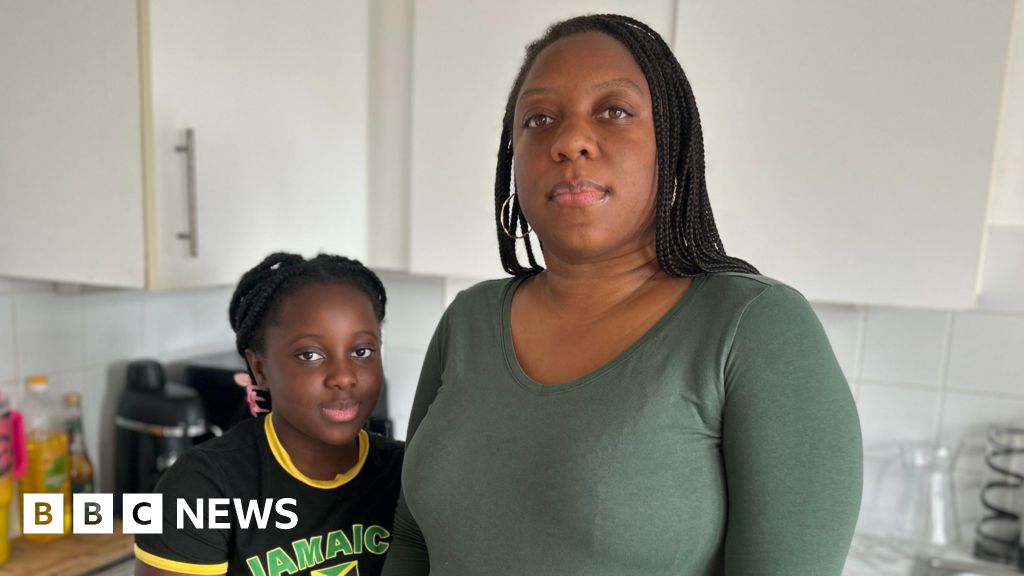Meghan OwenWork and money correspondent, BBC London and
Lauren StanleyBBC London
 BBC
BBCAs the UK experiences hotter temperatures families across the country are increasingly feeling the impact, with their homes no longer a sanctuary but an unbearable space that many are desperate to escape.
Keisha says her top-floor flat can reach up to 43C in summer, and the baseline temperature is around 31C.
“It should be illegal to live in these conditions,” says the 36-year-old, one of many parents who say that living in an “unbearably” hot flat is making their children sick.
Almost 5.5 million children – over half of those in England – are living in homes at risk of overheating, according to new analysis of the English Housing Survey 2022 by the Resolution Foundation think tank. Over a million of those children are living in London, mostly in social housing.
‘The heat makes her unwell’
Keisha has lived in her new-build flat in Woolwich, south-east London, for eight years.
Her nine year old daughter struggles in the heat, “unable to regulate her temperature”.
“She doesn’t feel well, her tummy often hurts.”
“The other night it was 20 degrees outside and she was crying at 3am. I take endless litres of water to her room just to make her calm down.”
Keisha often walks the streets at night or drives around in an air-conditioned car to escape the heat. She says air-conditioning for her flat is unaffordable, and she was quoted £8,000 per bedroom to install it.
Keisha’s housing association says that when the block was constructed, “it met all planning and building regulations at the time, however, along with most properties in the UK, with the extreme temperatures we’re now seeing, these buildings were not designed or built in a way which would keep them cool”.
Some housing associations are “extremely mindful” of the risk of homes overheating and are developing strategic climate adaptation plans to address the risks posed by hot summers, according to Alistair Smyth, director of policy and research at the National Housing Federation.
“We are committed to working with the government on this issue and we would support a national overheating strategy, with appropriate funding solutions, so that both new and existing homes can be adapted to withstand future climate change,” he told BBC London.

The Resolution Foundation, an independent think-tank focused on improving the living standards of those on low-to-middle incomes, is urging the government to ensure that the costs of remediating hot homes are affordable.
“Many people don’t have the means to invest to make their properties cooler,” says principal economist Jonathan Marshall.
Buildings in the UK are built to retain heat in a temperate climate, with energy efficiency regulations for new dwellings now requiring improved insulation to reduce the need for heating in winter.
“An effort [is needed] on making homes greener – insulating homes but doing so in a way that doesn’t make them overheat in the summer,” Mr Marshall says.
The foundation’s analysis of the 2022 English Housing Survey figures shows that over half the children in England are living in homes at risk of overheating.
“This is not just an issue that’s going to happen in the middle of July on a 35-degree day. If it gets to high 20s in early spring or late autumn, homes could overheat then too.”
Mother-of-two Sarah, who lives in Islington, north London, says she recorded 43C heat this summer in her living room, but thinks the bedrooms reach even higher temperatures. She says she spends more on electricity in the summer, to power fans in their two-bedroom flat, than she does in the winter.
“‘It makes the kids sick – they have no appetite. It affects our sleep.”

The block is surrounded by scaffolding because of cladding remediation work. Sarah says it’s a problem to open the windows because they’ve had intruders climbing on the scaffolding and workmen outside every day.
“The summers are going to get longer and hotter. Families can’t live the way we’re living. The amount of fans we’ve got 24/7 – it helps but it’s not a solution.”
Her daughter Maddie, 18, says it has taken a toll on her social life, because people don’t want to go to the flat.
“You can feel quite nauseous from it. I’ve had headaches from dehydration.
“I come out of the bedroom in the morning and I say, ‘Mum, feel my clothes’ – it’s like they’ve come off a washing line.”
Her brother, six, says the heat has made him physically sick.
Over a million of the estimated 5.5 million children living in homes at risk of overheating are in London.
“The issue of space is more acute in cities, especially in London, where homes are smaller,” Mr Marshall says. “Smaller homes are much more likely to overheat.”
He adds that single-aspect homes, with windows only at the front of a room, are hot in part because of a lack of airflow.
Dr Amaran Uthayakumar-Cumarasamy is an NHS paediatrician and member of health justice campaign charity Medact.
He says that signs a child has become overheated can include confusion, altered mental state, irritability, a raised core body temperature and nausea.
“Given the climate crisis and extreme heat are getting worse year on year, there’s never been a more urgent time to take action on our unsafe and unhealthy housing stock in the UK.”
The Royal College of Paediatrics and Child Health urged national and local governments to work with the housing sector to “adapt against heat stress as well as cold and damp in our current and future housing stock all of which impact on children’s health.”
“Young children are more vulnerable to heat-related illness”, says Helena Clements, its officer for climate change.
“As temperatures rise across the UK, heat will become an increasingly important consideration for paediatricians.
“Greater attention must be paid to raising awareness of the risks from heat and the adverse impacts in early life and during pregnancy, with families encouraged to follow government advice on keeping children cool.”
‘Architectural crisis’
The 2022 summer heatwave was one of the most intense recorded in the UK and caused 4,500 heat-related deaths, according to the Office for National Statistics.
Up to 10,000 people in the UK could die every year by 2050 from heat-related illnesses if no action is taken to adapt to our warming climate – although cold weather can also be the cause of excess deaths.
The country is facing an “architectural crisis”, says Andy Love, founding director of Shade the UK.
The community interest company has partnered with the London School of Economics to push for a user-friendly metric of overheating, similar to Energy Performance Certificates which rate a property’s energy efficiency, so that tenants and buyers understand heat risk to buildings before deciding whether to move in.
Mr Love adds that many homes in the UK have been built for temperate climates, and “do not function properly during hot weather” including blocks with “full floor to ceiling-height glazing, single-aspect homes”.
In the short term, Mr Love recommends putting a wet towel through the window to act as a blocker to the direct sun and leaving windows open when it’s cool in the evening to bring in air for the morning.
A government spokesperson said: “We are investing £13.2bn to improve up to five million homes over this Parliament, boosting the energy efficiency of housing to cope with higher temperatures.
“We are also taking action to strengthen climate resilience across government and local communities, improving our infrastructure and making sure homes are fit for the future.”
The government plans to set out its approach to overheating and cooling in the Warm Homes Plan, which will be published in October, and the Future Homes Standard.








